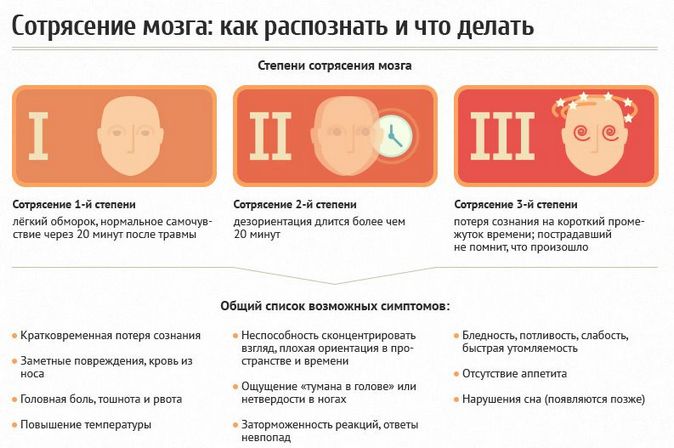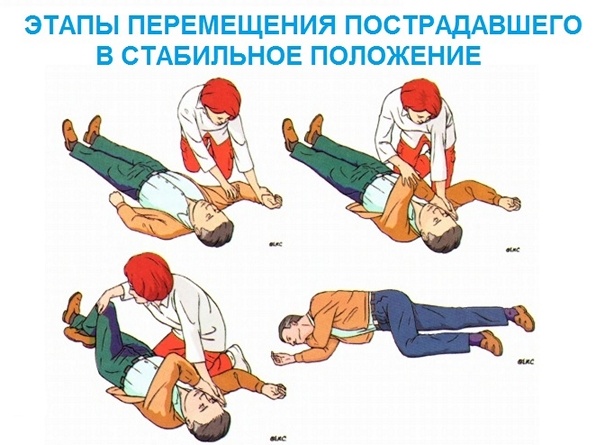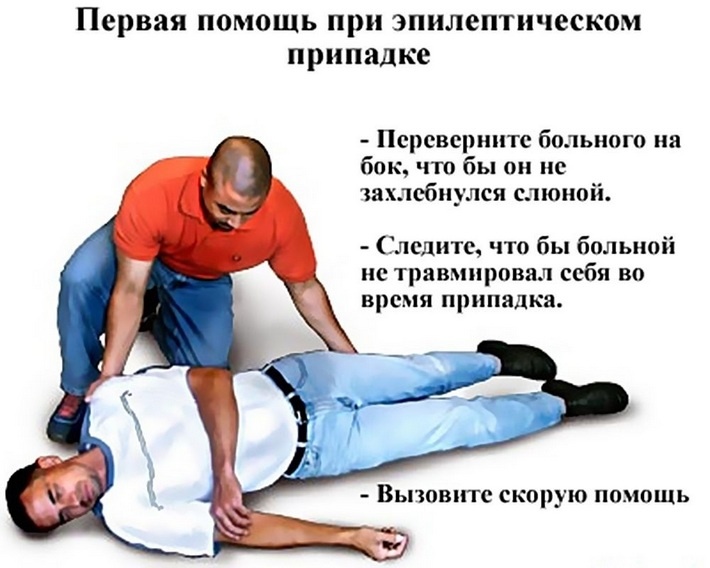Concussion (ICD-10 code - S06.0) is one of the mildest traumatic brain injuries associated with vascular damage. But, despite this, the consequences for the victim are sometimes quite serious, so this condition requires special attention and compulsory treatment. The cause of the injury is the impact on the head of mechanical factors (impact when falling, playing sports or in an accident). In order to pay attention to this condition in time, it is important to know the signs of a concussion.
Based on the name of the injury, it is clear that as a result of the impact on the human head of mechanical factors, the brain is shaken. After that, at the cellular level, there is a temporary disconnection in the work of different parts of the brain. It also happens. Later they expand, and this leads to the fact that for some time the blood flow is impaired. As a result, it affects some brain functions and nonspecific symptoms appear. Treatment for concussion involves taking medications, the action of which is aimed at resuming disturbed processes and relieving negative symptoms of trauma. It will help reduce the likelihood of developing various consequences.
You can get a visual representation of the injury by watching our video:
Trauma symptoms
The victim has the following symptoms of a concussion:
- Immediately after the impact, the victim is depressed (stunning, feeling of incomplete consciousness, fainting). This can last from half an hour or even more.
- Memory impairment, which is then restored. The victim may not remember what happened before the blow was struck, the blow itself and for some time after the blow to the head area.
- Single vomiting. With a mild degree of brain damage, it will not be repeated.
- Changes in heart rate (faster or slower), increased blood pressure. After a while, the condition returns to normal without medical intervention.
- Rapid breathing, which quickly returns to normal, so many may simply not pay attention to this symptom.
- After the concussion, the face becomes pale, and after a while, the skin turns red.
- The pupils dilate.

In adults, the following symptoms can be considered signs of a concussion:
- Headache (may be of a different nature and location).
- Dizziness.
- Feeling hot.
- Sweating.
- Feeling of tinnitus.
- Insomnia.
- Weakness in the muscles.
- Decreased concentration of attention.
- Staggering while walking.
- Sensitivity to light and loud sounds.
Despite all these consequences, the body temperature does not change.
Doctors note that during the first 7-10 days after the concussion occurred, the general condition of the victim stabilizes. However, a symptom such as a headache, which is often a consequence of a concussion, can be felt for a long time.
Doctors of the program "It's great to live!" understand the symptoms and treatment of trauma in adults and children:
The overall picture of trauma may differ depending on the person's age. So in infants and young children, impairment of consciousness does not occur. At the very beginning, their pulse quickens and their skin turns pale. A little later, parents may notice drowsiness and lethargy in the baby. During feeding, babies spit up. Children have vomiting, sleep disturbance, they become restless. Within a few days after the incident, all symptoms disappear.
Loss of consciousness after injury is uncommon in older people. But they have a more pronounced concussion symptom of a disturbed sense of orientation in space. During the first week, they may be disturbed, mainly in the back of the head. Patients with hypertension are more susceptible to such consequences than others.
Diagnostics
The determining factor in the diagnosis is the very circumstance of the injury and eyewitness accounts. In most cases, this injury does not have diagnostic features that could be considered objective. Immediately after injury, there may be such obvious symptoms of concussion, such as: impaired consciousness and coordination of movements, loss of balance, etc.
Additionally, in order to confirm the diagnosis and exclude any consequences of the injury, the doctor will prescribe:
- X-ray to help exclude displacement of the vertebrae, fracture or fracture of the skull, etc.
- Encephalography makes it possible to see focal lesions that can occur in the vessels.
![]()
- prescribed in case of serious injury to determine the changes that could occur in distant parts of the brain.
- Analysis of the condition of the fundus allows you to determine a hematoma or hemorrhage.
The severity of the injury
There is a division according to the severity of the injury, however, it is conditional. The main criterion by which this can be done is the time that the victim was unconscious. There are such degrees of TBI:
- Mild - the duration of unconsciousness did not exceed 5 minutes or was absent altogether. In this case, the condition of the victim is assessed as satisfactory, and symptoms such as impaired feelings, movements, etc. are not observed.
- Medium - no consciousness for more than 15 minutes. If we talk about the general condition, then it is assessed as moderate. The victim has neurological symptoms, nausea and vomiting.
- Severe - the person was unconscious for more than 15 minutes, there is tissue damage. At the same time, the general condition is serious and is characterized by a vivid disruption of the work of all organs. The victim needs urgent help.
Concussion treatment
Even taking into account the fact that a concussion is usually called a minor injury, it still requires compulsory treatment. A mild degree allows for the treatment of concussion at home, but under the close supervision of the attending physician. Although many doctors recommend a hospital stay. This is due to the fact that during the post-traumatic period, unpredictable consequences of TBI, such as subarachnoid hemorrhage, etc., are possible.
First aid
Similar to other injuries, a concussion requires first aid, which will determine the patient's further condition and the possibility of complications and other consequences. Basic first aid for a concussion is limited to the victim's rest.
Honored Doctor of Russia, military surgeon will tell how to provide first aid, to replace the director of the Center for Disaster Medicine "Zashchita" Leonid Borisenko:
If the victim's consciousness is not impaired, he must lie down with his head slightly raised. If he remains unconscious after 5-10 minutes, you need to:
- Lay on one side (recommended on the right).
- Throw your head back so that your face is directed downward.
- Place your left arm and leg at a 90-degree angle at the joints. This will make it possible to exclude consequences such as a fracture of the spine or limbs.
In this position, the victim will be able to breathe normally, and in case of vomiting, the liquid will flow down and not enter the respiratory tract.

If there are injuries on the head (wound, abrasion, etc.), they must be treated.
Even if the concussion seems mild, the patient needs mandatory bed rest for several days. Later, if a person feels good, it can be gradually expanded: you can get up, walk, etc. What is done at home in case of a concussion, the attending physician will tell.
Drug treatment
Often, special treatment, which involves taking medications for concussions, is not performed. Drug therapy that a doctor may prescribe is aimed at normalizing brain function, eliminating insomnia, anxiety, etc. For this, certain drugs are prescribed: sedatives, pain relievers and hypnotics:
- To relieve pain in the head area, use: "Ibuprofen", "", "Analgin", "Sedalgin", etc.
- In case of dizziness, it is possible to take: "Cinnarizin", "Tanakana", "Balloid", etc.
- Among the sedatives, most often prescribed are: "Valerian extract", "Motherwort tincture", "Phenazepam", "Sibazon", etc.
- To combat insomnia use: "Relaxon" or "Donarmil".

The main effects of peripheral analgesics
- Vascular therapy consists in taking drugs such as: "Glycine", "Noopept", "Cavinton", "Nootropil", "Diacarb", etc.
- As antioxidants are prescribed: "Mildronate" and "Cytoflavin".
- In case of asthenic phenomena, a technique is shown: "Kogituma", "Vasobrala".
- Additionally, it is prescribed to take multivitamin complexes.
- In the treatment of concussions in the elderly, anti-sclerotic therapy is prescribed.
Treatment with folk methods
Phytotherapists offer their treatment for concussion using decoctions and infusions of some medicinal plants. Such means are considered effective:
- Infusion of motherwort, mistletoe, mint and lemon balm. To do this, the dried ingredients must be taken in the same amount and mixed. 1 tbsp. l. such a mixture is brewed with 0.5 liters of boiling water and infused overnight. The next day after straining, divide the infusion into equal parts and drink 4 times during the day.
- Mint, chamomile, hop cones, lemon balm and valerian root (20 g of each plant) are mixed. 2 tbsp. l. the resulting mixture must be poured with boiling water (0.5 liters). Let it brew for 20 minutes. Then strain the product, divide into 6 parts and take during the day.
You will learn more recipes by watching our video:
Complementary treatment
Treatment of concussion with the use of traditional and traditional medicine is complemented by a course of massage, physiotherapy, relaxation therapy.
No special diet is required in this case. The patient is allowed to eat his usual food, giving preference to healthy food. However, during the period of treatment and recovery, he needs to completely exclude strong drinks, including not only alcohol, but also black tea and coffee.
Effects
If the treatment was prescribed correctly, and the patient complied with all the prescriptions of doctors, then basically his condition is completely restored. But there are situations when a person has the consequences of a concussion. These include:
- Post-concussion syndrome. This condition is considered the most severe consequence of traumatic brain injury. Its development may take months. It usually occurs after a few days, although there have been cases when it was observed several months after suffering a concussion. Its manifestations include: nervousness, attacks of acute headache, insomnia.
- Increased excitability and psychoemotional instability. The person can become aggressive and irritable.

- Convulsive syndrome, which is very similar to epileptic seizures. In this case, the person is prohibited from driving.
- Hypersensitivity to alcohol.
- Vegetovascular disorders, which can be considered as drops in blood pressure, dizziness and headache, excessive sweating, etc.
- Depressive states, development of phobias.
Any consequences of a concussion can be minimized by a high-quality examination, determination of the patient's condition and the appointment of treatment.
Concussion can be called the mildest of all traumatic brain injuries, which is diagnosed more often than others. From others, it is distinguished by the ability to restore brain functions. To do this, it is necessary to start treatment on time and follow all the doctor's prescriptions in order to quickly normalize the condition and prevent the development of serious consequences.

